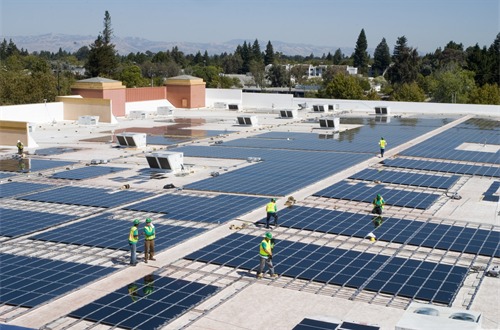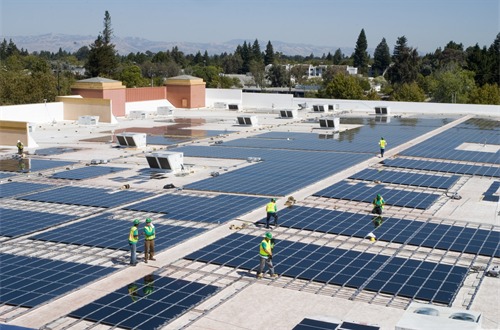 Walmart installed thin-film solar cells on this store in Mountain View, Calif. The company plans to put similar panels on 20-30 more stores.Photo: WalmartWhen Walmart announced on Monday that it would install 15 megawatts’ worth of solar arrays on as many as 30 of its stores in California and Arizona, it set out to shape the solar market in more ways than one.
Walmart installed thin-film solar cells on this store in Mountain View, Calif. The company plans to put similar panels on 20-30 more stores.Photo: WalmartWhen Walmart announced on Monday that it would install 15 megawatts’ worth of solar arrays on as many as 30 of its stores in California and Arizona, it set out to shape the solar market in more ways than one.
The reason? The world’s biggest retailer specified that many of the new solar installations should use thin-film photovoltaic panels. Thin-film solar cells are printed or deposited on glass or flexible materials. And although they are less efficient at converting sunlight into electricity, they can be produced at a lower cost than traditional crystalline silicon solar cells.
Thin-film solar currently accounts for just about 20 percent of the solar market. The most technologically advanced versions have had a difficult time grabbing market share due to competition with low-cost Chinese crystalline silicon manufacturers and a recession that has dried up investor funding.
Enter Walmart.
“By leveraging our global scale to become a more efficient company, we are able to lower our expenses and help develop markets for new technologies,” Kim Saylors Laster, Walmart’s vice president of energy, said in a statement. “Developing and incorporating new renewable energy sources, like thin film, reduces energy price risk and aligns very well with our commitment to solving business challenges through technology.”
Walmart signed a deal with SolarCity, a leading Silicon Valley solar installer, to manage the project. SolarCity will install and own the photovoltaic arrays on Walmart stores and sell the electricity to the retailer.
SolarCity’s chief executive, Lyndon Rive, told me Monday that the company will install thin-film solar arrays made by First Solar and Miasolé.
First Solar, which makes an older variant of the technology called cadmium telluride, is the world’s biggest thin-film manufacturer and Walton family members were early investors in the Tempe, Ariz., company. First Solar is also an investor in SolarCity, which already uses its photovoltaic panels.
Miasolé, a Silicon Valley startup, is one of a number of companies that has developed a type of thin-film solar cell called copper indium gallium selenide, or CIGS, that offers the promise of higher efficiencies and lower costs.
“Walmart wanted to see thin-film be adopted and made that a requirement in the bidding process,” says Rive.
He noted that the retailer did not dictate the percentage of stores that should receive thin-film solar arrays but expects the technology will account for the majority of installations over the next year.
“There’s no hard and fast number but they’d like us to do as much as possible,” said Rive.
Another twist in the Walmart deal is that the company collaborated with the Environmental Defense Fund (EDF) to develop the criteria used to select SolarCity. (EDF, which maintains an office near Walmart’s headquarters in Bentonville, Ark., has long worked with the retailer on sustainability initiatives.)
The goal, Walmart said in a statement, “was to identify the most innovative solar technologies that would create benefits on three fronts — to the environment, technology, and financial viability.”
The bigger ambition, though, is to shape the solar market, as Walmart acknowledged.
“The company’s large scale on-site installation of CIGS could help further the development of this technology and bring it to market quicker, while use of cadmium telluride thin film could help make the case for other businesses to adopt the technology for on-site commercial use.”



